Effective 5- to 7-Minute Reading Conferences

In the Reading and Writing Strategies Facebook Group, a member recently posted this question:
I started conferring this week and I can’t seem to keep the conferences to the recommended 5-7 minutes. What tips and tricks have you implemented to help you keep your conferring times down to the recommended time? I would set a timer, but I feel like it would be disrespectful to the student that I am with…Any suggestions would be appreciated. –Jenny H.
I promised Jenny and others who expressed an interest that the question deserved a whole blog post….so here it is!
It’s hard to argue with the power of conferring: individualized instruction where teachers provide meaningful targeted feedback to each student. But to ensure that all children benefit – and that each student can have regular reading conferences with you – it’s important to keep them focused and to be mindful of your time.
Here are my tips for being time-efficient while not sacrificing impact or feeling rushed. (Click images to enlarge.)
Tip #1: Stick to a structure
When you know how you want the conference to go, it’s easier to adapt, adjust, and be responsive within the conference. I recommend the Research-Compliment-Teach (R-C-T) structure, something I learned from Lucy Calkins almost two decades ago that I still use today. I spend about a minute researching or checking in to see how the student is doing, then I decide on one thing to compliment and one thing to teach. Next I compliment in a sentence or two, reinforcing a strategy the child is already using.
Then I teach by offering a step-by-step strategy and supporting the student as they have a try. Finally, I link to their independent work with a quick reminder of what we worked on, leaving the student with a simple visual reminder. You might even keep these steps in front of you on a table tent as you work!
Tip #2: Don’t open too many cans of worms
During the research phase of the conference, it can be tempting to ask a lot of questions, look at all the artifacts (Post-its, notebook entries, etc.) that the student has produced since the last time you met, and get into the weeds. It can be overwhelming to get so much information because it makes it harder to focus and choose what to teach. It also makes the conference feel less like a conversation, and more like you’re grilling the student.
Instead, begin the conference with the student’s goal in mind. Research only connected to that goal. For example, if the student is working on improving fluency, then just have them read aloud. If the student is working on better understanding the plot, then ask them to retell.
Tip #3: Keep skill progressions in mind
Conferences are most impactful when they are focused on a student’s goal. Though the goal is something the student cannot yet do, there is a progression of skills within the goal. The best targeted teaching leans on what a student can already do (where they are on the progression of skills) and nudges them toward deeper work. For example, if a student is working on a goal of understanding text features, the progression might look something like this:
If you determine the student is able to offer multiple details from the feature, you might think, “What’s just a little more than what they are doing now?” and help the child with a strategy to connect the information from the feature to the information in the rest of the text.
In doing so, you’ve based a teaching opportunity on a strength. You’re working within the child’s zone of proximal development. Doing so boosts a student’s confidence and makes it more likely that the child will be able to approximate in the few minutes they have with you, and continue independently when you move on to another child.
Tip #4: Teach one thing
Teachable moments abound in every moment of the teaching day, and conference time is no exception. It’s inevitable that you’ll be in the midst of teaching a student about improving fluency by noticing mid-sentence punctuation when they get stuck on a word. You might be tempted to switch gears and teach a decoding strategy. In most cases, my advice is to stay focused on the one thing you taught, make note of what else you noticed, and plan to support what else the student needs in a subsequent conference.
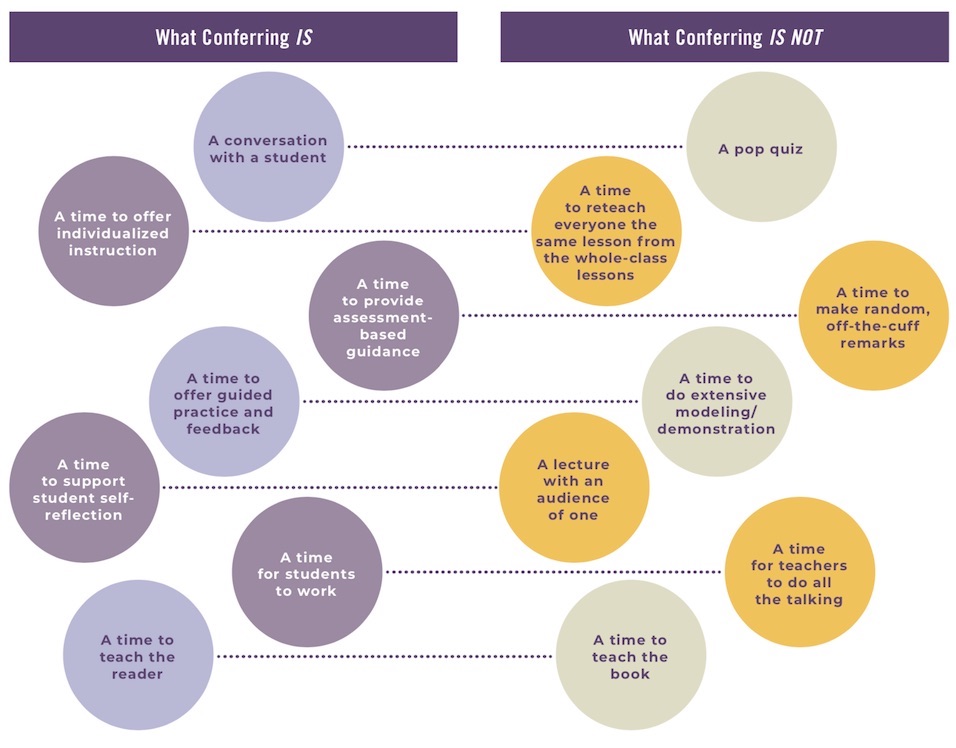
Tip #5 Don’t model (or if you do, keep it short)
I used to do a lot of modeling/demonstrating in conferences and would spend two or more of my five minutes doing a lot of talking, showing, and telling. My experience tells me that in a one-on-one situation, it’s just as effective (and much more efficient) to get the student to just try what you want them to do and give them coaching and feedback as they work. No demonstration needed.
So now, I always try that first—I just tell the step-by-step strategy, and get the student to practice while I coach. If the student needs a quick example or demo, I’ll do it only after I’ve given them a chance and they show me they need more support. And even then it’s short—just one quick example.
Tip #6 Let it go
Conferences are an opportunity to give the student some supported practice. It’s ok to leave before the student masters what you’ve taught. Like with piano lessons where the teacher leaves when time’s up even if the piece isn’t perfected, in conferences we need to move on to other students and trust that there is value and potential for progress in the independent practice time in between each session.
Leave the student with a sticky note or book mark to remind them of what you worked on (just as a piano teacher leaves sheet music with marginal notes) and plan to see them a few days later.
Tip #7 Confer in groups when more than one student needs the same strategy
As you set goals with students and see them regularly, you’ll start to notice patterns in your class. “Hey, these three are all working on retelling the plot of simple chapter books” you might notice, or “These two are both trying to infer character feelings.” It makes great sense, then, to pull students together to save time.
In a small group conference (AKA “strategy lesson”) you can start by telling the children why you’ve pulled them together, offer a strategy that everyone will practice on their own, and move around the group coaching and giving feedback one-on-one. These small group conferences last about the same amount of time as individual conferences, but you can work with two or three children at a time.
Learning to use less time…takes time!
Just as your students need to practice strategies to work toward their goals, you’ll likely find that getting your conferences focused and short will take time, too. Be as patient with yourself as you are with your students. Work on one of these tips one at a time, reflect, improve!
Read Rita Platt’s review of
A Teacher’s Guide to Reading Conferences
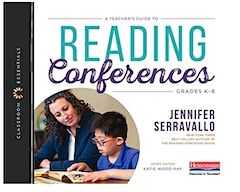
Jennifer was a Senior Staff Developer at the Teachers College Reading and Writing Project and taught in NYC public schools. Find her on X-Twitter @jserravallo, Instagram @jenniferserravallo, or the web at www.jenniferserravallo.com, and join the Reading and Writing Strategies Facebook Group to have your questions answered.

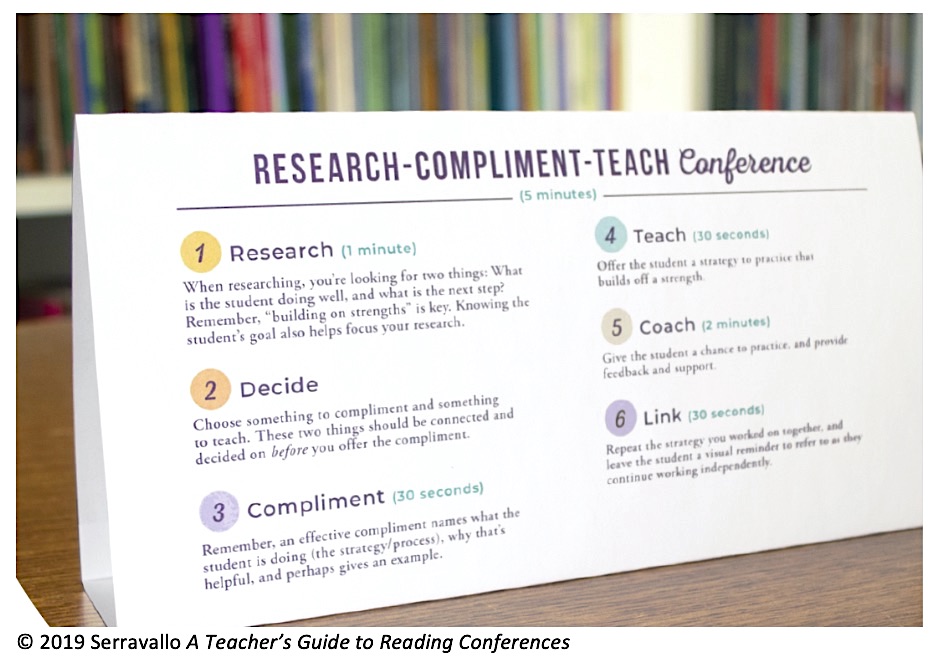
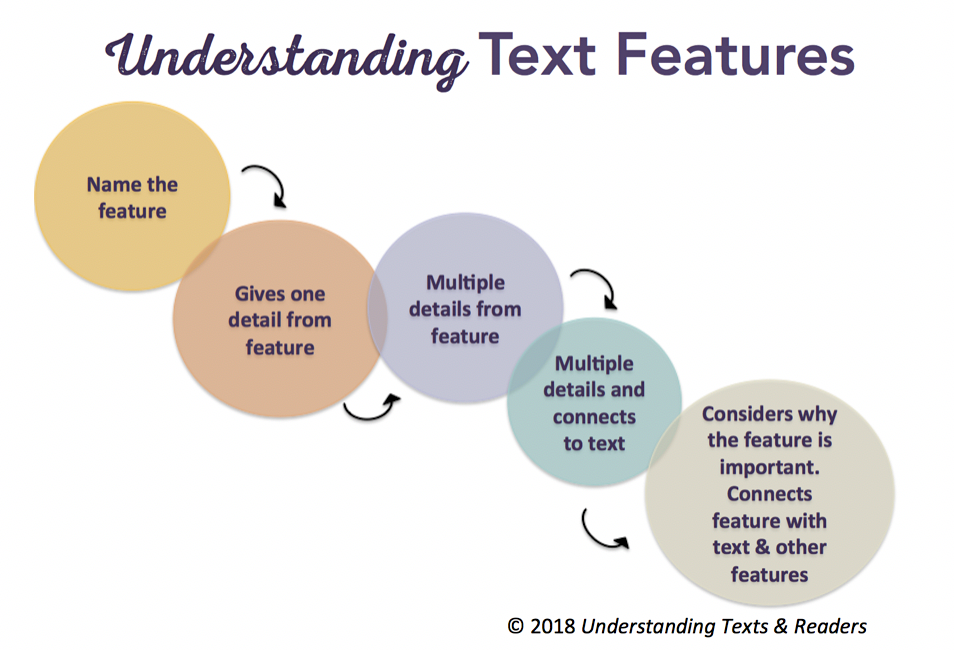
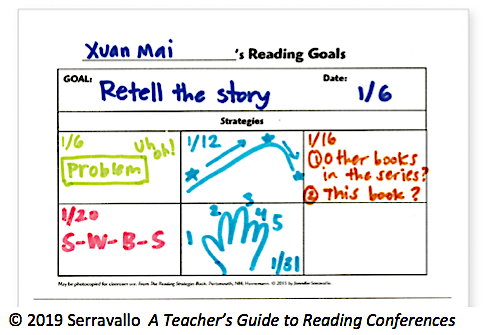
































Thanks for this Jennifer. I have started pulling groups based solely on BAS. Now would like to meet individually with my students and use the research form from the conference book that has all of the comprehension strategies. I’m curious if you think that type of conference will take a bit longer or should I be trying to keep it at 7 ish minutes? For the record I loved your conference book. It really helped me make sense of the conferences and how to use the other “big”strategies book.
Thank you l! This is so practical.
Can’t wait to pass along to others – Thanks!
Thank you for this article, Jen! It provides such clear ideas on how to make conferencing manageable!
I especially love the R-C-T strategy and the Teach-One-Thing approach too!
Thank you for the good tips!
Thank You for tips, they are a must try.
Thank you for support in conferences, knowing that time limits seems to be a challenge. So much you want to hear from your student and so much you want to give.